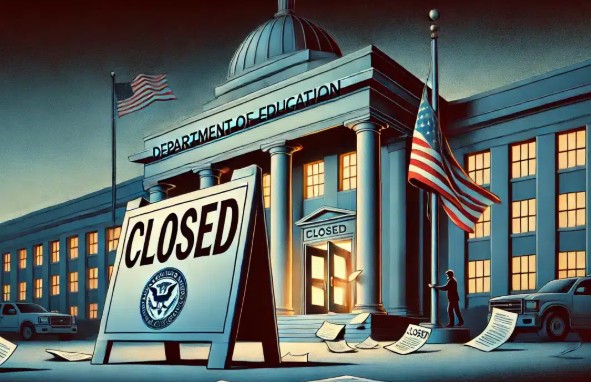HISTORICAL CONTEXT: HOW THE U.S. DEPARTMENT OF EDUCATION WAS FORMED
And now onto our main discussion regarding the debate on eradicating the US department of education; and we ought to begin with the historical context on how the US education department was formed. So, in 1867, President Andrew Johnson signed legislation to create a Department of Education. It was seen as a way to collect information and statistics about the nation’s schools and provide advice to schools in the same way the Department of Agriculture helped farmers. The department was originally proposed by Henry Barnard and leaders of the National Teachers Association, renamed the National Education Association. Barnard served as the first commissioner of education. Interestingly, he resigned when the office was reconfigured as a bureau, called the United States Office of Education, as part of the Department of Interior – and this was notably due to concerns that a “department of Education” as it were, would have too much control over local schools.
Over the years, the office remained relatively small, operating under different titles and housed in various agencies, including the United States Department of the Interior and the former United States Department of Health Education and Welfare (also known as DHEW), and which is now called the United States Department of Health and Human Services. Then, in 1920, an unsuccessful attempt at creating a Department of Education, headed by a secretary of education, came with the Smith–Towner Bill. Following this unsuccessful attempt, in 1939, the organisation, which was still then a bureau of education (as opposed to a department), was transferred to the Federal Security Agency, where it was renamed as the Office of Education. Then, after World War II, President Dwight D. Eisenhower promulgated “Reorganization Plan No. 1 of 1953”. The Federal Security Agency was then abolished and most of its functions were transferred to the then newly formed United States Department of Health Education and Welfare (or DHEW).
It was then in 1979, that the Department of Education was promoted into being. US president Jimmy Carter advocated for creating a cabinet-level Department of Education. Carter’s plan was to transfer most of the Department of Health, Education, and Welfare’s education-related functions to the Department of Education. Carter also planned to transfer the education-related functions of the departments of Defense, Justice, Housing and Urban Development, and Agriculture, as well as a few other federal entities. Among the federal education-related programs that were not proposed to be transferred were Headstart, the Department of Agriculture’s school lunch and nutrition programs, the Department of the Interior’s Native Americans’ education programs, and the Department of Labor’s education and training programs.
What is noteworthy about the creation of the Department of Education under president Carter is that upgrading Education to cabinet-level status in 1979 was opposed by many in the Republican Party, who saw the department as unconstitutional, arguing that the Constitution does not mention education, and deemed it an unnecessary and illegal federal bureaucratic intrusion into local affairs. However, others saw the department as constitutional under the Commerce Clause, and that the funding role of the department is constitutional under the Taxing and Spending Clause. The National Education Association supported the bill, while the American Federation of Teachers opposed it. Nevertheless, it was created. But, while this is a relatively abridged version of the history, it remains an essential and notable takeaway that from the 1860s to the 1970s – the existence of a Department of Education was always controversial because of concerns of the amount of power it would have, and also how much it undermines states abilities to legislate on the matter.
WILL THE CLOSURE OF THE D.O.E. DISPROPORTIONATELY HARM AFRICAN AMERICAN STUDENTS?
So let’s proceed to address the opposing sides in the debate on eradicating the US DOE. The first, notably comes from the left, and Democrats who argue that this ill disproportionately negatively affect African American youth, because the DOE was created to standardise education in a time where one’s access to quality education was dependent on their race, gender and class. This view was notably articulated by Representative Ayanna Pressley.
Let’s directly respond to this. And, in essence, Representative Ayanna Pressley’s “history lesson” on the Department of Education’s creation conveniently skips over crucial details, but let’s balance the historical accounts. First, yes: the Department of Education was created in 1979 – making it one of the US’ youngest cabinet departments. Now, we established earlier that it was formalised as a department under US president Jimmy Carter. Well, this was not necessarily to bridge racial, gender or class gaps – this was a political reward from president Carter to the National Education Association after receiving their first-ever presidential endorsement. That’s not partisan speculation; it’s documented history.
Furthermore, before this department existed for 90% of American history, the American education system somehow managed to produce generations of scientists, writers, inventors, even civil rights leaders who constructively pushed the discourse on racial laws and politics in the US. So, is it not curious that since its creation, America has seen declining test scores, skyrocketing costs, and growing achievement gaps?
In addition, Representative Ayanna Pressley claimed that eliminating the Department would “set America back decades”. However, it is not clear what the measure of progress is when she makes this claim. This is especially considering that the National Assessment of Educational Progress shows 70% of 8th graders reading below proficiency and 72% as below proficiency in mathematics.
Meanwhile, the DOE has become a centralised bureaucracy that’s spent $200+ billion during COVID alone with little accountability for results. The Department employs over 80 Public Relations staffers (for $10 million annually) while managing a $1.6 trillion student loan portfolio with fewer staff than a mid-sized bank. Defending the DOE is therefore not defending access to quality education (especially for African American, female or less privileged youth); it is rather about defending administrative bloat – the very thing that president Trump seeks to dismantle through DOGE and the executive order he signed.
Furthermore, the existence of the DOE was historically justified based on a report published in 1983, which was 4 years after the DOE was created. The report, which was titled “A Nation at Risk: The Imperative for Educational Reform” came from the United States National Commission on Excellence in Education. Its publication is considered a landmark event in modern American educational history. Among other things, the report contributed to the ever-growing assertion that American schools were failing prior to the DOE’s existence. But, the report is said to have manipulated crucial facts.
THE D.O.E. WAS INSTRUMENTAL IN INFILTRATING SCHOOLS WITH THE WOKE AGENDA
Let’s proceed to address why the institutionalisation of the US DOE was inherently bad. And this has to do with the concerns that were raised for decades – including the 1860s under president Andrew Jackson. In essence, the DOE gave too much power to the federal government. And the quintessential attribute of too much power is that it corrupts, or can be corrupted itself.
More than ever, this was perhaps notable under the Obama administration. The Obama administration used the DOE to infiltrate schools (and subsequently the youth) with a mentality of perversion, hyper sexualisation, and so-called woke agendas that America is still having to correct even today. And the goal was not just to infiltrate schools with this mentality, it was to change the social fabric of America beginning with that generation, because schools are a known socialisation agent. And so, essentially, the Obama administration took a page from the autocratic regimes that sought to standardise a mentality in an oppressed population through corrupting the education (and media) of the society. [PAUSE] If this is what a DOE enables a federal government to do, then the very institutionalisation of such a department cannot be supported – it is no different than allowing a federal government to create a ministry of propaganda aimed at the youth of a nation.
WHAT DOES PRESIDENT TRUMP’S EXECUTIVE ORDER DO, AND WHY IS THIS IMPORTANT?
Now, in light of all of this and more, President Donald Trump signed an Executive Order returning power over education to families instead of bureaucracies on the 20th of March. The Executive Order directs the Secretary of Education – being Linda McMahon – to take all necessary steps to facilitate the closure of the Department of Education and return education authority to the States, while continuing to ensure the effective and uninterrupted delivery of services, programs, and benefits on which Americans rely. The Order also directs that programs or activities receiving any remaining Department of Education funds will not advance DEI or gender ideology. And all of this is about dismantling the education bureaucracy and returning the decisions on education to parents and states.
THE CLOSURE OF THE D.O.E. AND THE SCHOOL CHOICE MOVEMENT
It is important because it empowers the school choice movement. The Department of Education reports that the government spent an average of $14,295 per student in public schools from elementary through 12th grade in the 2020–2021 school year. As a result of this, many conservatives support the idea of school choice, saying it will force failing public schools to improve or lose students. And more importantly, they say, those failing schools will lose the funding they receive to educate the children who leave. Some parents who’ve previously paid for their children’s private school tuition or homeschooling expenses on their own, with no government assistance, say school-choice programs bring about much-needed fairness. That’s because—by paying taxes—those parents contribute to the public money used to pay for public education. But they’ve received none of the benefits, and still have to cover the costs of their children’s education.
Then on the other hand, there is also a strong lobby movement that’s against school choice. Public schools are deeply connected to some of the most potent activist groups in American society—the teachers’ unions. And though polls show parents strongly favour school choice, unions are adamant in their opposition. For example, the National Education Association states that “Vouchers take scarce funding from students in public schools and give those resources to unaccountable private schools.” The National Education Association also says that vouchers, used in school choice programs, don’t support disabled students, don’t protect the human and civil rights of students, and “exacerbate segregation.” In addition, the American Federation of Teachers (AFT) states on its website that evidence “does not support the argument that vouchers and other methods to establish a market system of schools will improve school or student performance.” And both these organisations are two of America’s largest unions, with a combined total of more than 4.7 million members.
But this matter is politicised beyond teachers’ unions. In fact, here is senator Heidi Campbell from Tennessee, complaining that school choice takes taxpayers monies to evangelical hedge fund schools.
What is ironic in her remarks is that she went to her so-called privatised evangelical hedge fund schools. And so, why should other parents be denied the opportunity to do the same for their children? Secondly, the opposition to funds going to private faith-based schools is not necessarily about money. It is about parents having the ability to emancipate their children from schools that teach values and ideals they oppose, but are entrenched in public schools. Because you would note that the school choice debate has especially gained traction in an era where the left has been dragging critical race theory and LGBT propaganda into schools. That’s where the issue really is, because at the end of the day, the parents taking their children to faith-based private schools are likely also taxpayers simply deciding where the money allocated for their children’s education will be spent. They are not stealing from anyone.
THE (INVALID) OPPOSITION TO THE SCHOOL CHOICE MOVEMENT
But, let’s proceed to directly address the opposition towards school choice, and assess whether this opposition has validity. Essentially, it appears that the biggest opposition to the school choice movement is on three fronts; namely (1) competition (2) giving parents more choice, and (3) the fact that children will go to faith-based schools. The underlying fact here is that teachers unions and bureaucrats want to entrench a monopoly on education, and thus making it difficult for parents to have wiggle room in making decisions that pertain to the education of their children, say for example, if a parent wants to take their child to a faith-based school that does not endorse the LGBT agenda. And so, the two main groups that are opposing the school choice movement are teacher’s unions and public school districts, and they are opposing it because right now they have a virtual monopoly on education, especially considering that 91 percent of students go to public school. And so, these two actors see the competition that would be brought by school choice as a threat.
HOWEVER, THE SCHOOL CHOICE MOVEMENTS CONTINUES TO GAIN TRACTION
However, despite this opposition, the school choice movement has continued to gain traction. In fact, in addition to the victories in West Virginia in 2021 and Arizona in 2022, and then Iowa, Utah, Arkansas, Florida, Oklahoma, Ohio, and Indiana, the movement has also scored wins in Texas and Alabama, with multiple defeats of targeted anti-school-choice Republicans in the Texas primary, and Alabama’s enactment of a comprehensive school choice program.
Texas governor Greg Abbott had made school vouchers his top priority, pouring more political capital into the vouchers than any other issue in his eight years in office. He campaigned for reelection on the issue in 2022 and made universal education saving accounts a central theme of his most recent State of the State addresses. The ESAs would use taxpayer funds to provide parents a voucher worth $10,500 a year per student to use at a private school. Furthermore, he had made school choice a top legislative goal of the 2023 Texas legislative session. But, his agenda was thwarted by 21 Republicans who helped the Texas House thwart the measure in a final 84-63 vote.
In addition, Texas teacher unions had staunchly and successfully opposed school-choice bills for years on the claim that the programs deprive public schools of essential funds and mainly benefit wealthy families who are already sending their children to private schools. HOWEVER, the Texas GOP primaries results in March showed that school choice was actually an important issue. This was especially evidenced by the fact that six anti-school choice incumbents were ousted, our more were forced to runoffs, and ultimately 77% of the incumbents challenged by those in favour of the school choice movement either lost or were forced to runoffs – thus marking the largest political shift towards school choice in Texas history. In light of this support for school choice, when the House Committee on Education and the Workforce held a hearing in 2023 entitled, “American Education in Crisis,” Rep. Brandon Williams shared crucial insights on school choice and how to address some of the issues surrounding this movement in order to maximise their obvious benefit.
Written by Lindokuhle Mabaso



